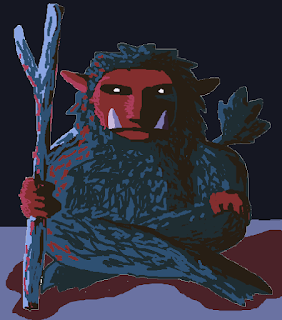Part of a series on worldbuilding around the idea of classes forming homogeneous races and tribes. This contextualizes classes and the constraint creates a world that might be interesting to imagine. All the surface world is a dangerous wilderness, filled with monsters and extreme weather hazards. That is why all civilized races sough protection though fortesses, numbers, alliances or other diversions.
6. MONKS.
Ogres, however, rely solely on their strength. Hardships of the world are welcome to them, because this trains their muscles and their wills. When you play an ogre (or Oni, Cyclops, Troll, etc. Any of those big brutes) just take the monk class.
On their natural habitats, they do all the clichés about breaking forests into lumber or mountains into quarries in order to test their skills, or meditating interposing their titanic bodies against a waterfall. The quirky thing about their civilization is that they are of the few that dare to live by themselves without any nearby help.
This allows them to do some things that other tribes would think twice to attempt: To lead flocks of sheep and cattle across long routes, to build monuments in the middle of the nothing or to mantain hives of giant bees for trading with the mead and honey, among others. Merchants make trade routes towards their dwellings to get their valuable supplies.
Low level monks are your classic Ogre foes, or maybe just young ones that have not grown up yet. Sometimes, mostly when ogres are fond of gold and earthly pleasures instead of spiritual paths, they gather in small mob-style gangs.
High level monks can be masters and might even get students if they pass some test (but makes sense that if they do, they still level up as their respective class). On a gamist perspective they are great PCs, NPCs and Monsters which is the important thing.
Ogres do not gather in cities, but they do build. Their architecture is often inhabited and scattered across the land: Temples, shrines, dojos, apiaries, towers, mills, bridges, dams, shelters for shepards, memorials and tombs (which again, gives many in-game possibilities for putting interesting shit on the game). Sometimes, making them is part of a training, as, for example, a sensei ordering young students to build a dojo before they can be trained; but then they discover that building it they gained lots of strenght that was needed for applying the teachings.
Ogres are however very frugal when builing their own homes. The classical lair of a mountain monk is a stone chimney and half a cabin built against the rock, and nearby shishi odoshi:
7. WIZARDS
You know about Swan Maidens? Those girls that bathe in the river, then a prince steals their swan dress and must marry him to get it back? And that are also on D&D bestiaries? Well, that is a concept that ties well into wizardry via one of my recurrent obsessions: Loom (the LucasFilm game).In that game, there is a tribe called The Weavers, which are functionally their world "magic men". They weave spells, using lots of spinning and weaving themes and terminology. They also related to birds, specially swans, as one of their highest spells allows them to shapeshift into this animal.
Their tribe or tribes take the shape of disheveled tents on the outside, but on the inside they have "folding" spells that make of them big and sophisticated if they need. I imagine their elders casting spells of hiding and distracting the senses in order to protect the village.
They use distaffs and put spells on things, mostly in clothes. To learn their spells they must observe the world around them and look for patterns hidden on certain things. This is a good motivation for adventuring, for characters that are to be PC's hirelings (and eventually PCs)
Transformation in bird is a spell on the list, not too low level, not to high either. It might not be tied to a Swan specifically, but other similar birds depending on the personality of the caster. In oriental folklore, the myths feature crane maidens instead.
The weaving themes can also be tied to the norns and fate. The wandering, lonely nature of the wizards also bears resemblances with the norse völvas.
It would have been easier to make it so all wizards live on a high-towered wizardry school, like in Earthsea. But we are making it so all classes are sort of "born into it" and wizard schools imply the opposite. It takes out some of the class endogamy.







No comments:
Post a Comment